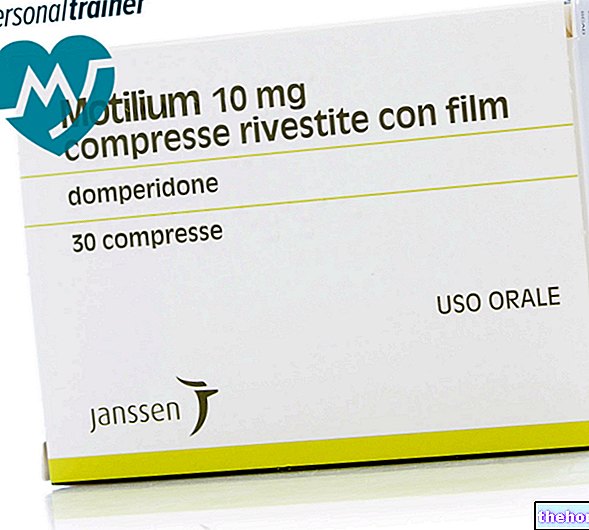Active ingredients: Disulfiram
ETHILTOX 200 mg tablets
Why is Etiltox used? What is it for?
ETILTOX is an adjuvant in the treatment of chronic ethylism which acts on the metabolism of alcohol in the body. In particular, disulfiram inhibits aldehyde dehydrogenase, the enzyme responsible for the oxidation of acetaldehyde, an alcohol metabolite. "alcohol intake there is an accumulation of acetaldehyde in the body which determines the appearance of the so-called" acetaldehyde syndrome ", during which the patient experiences a sensation of heat, headache, dyspnoea, nausea, vomiting, palpitations, tachycardia, hypotension, pronounced anxiety, weakness, dizziness and mental confusion. The duration of these symptoms varies from 30 to 60 minutes, but can last for a few hours in the most severe cases as long as the alcohol remains in the blood.
THERAPEUTIC CATEGORY
Adjuvant drug in the treatment of chronic alcoholism.
THERAPEUTIC INDICATIONS
Treatment of cessation of chronic alcoholism.
Contraindications When Etiltox should not be used
Known individual hypersensitivity to the active substance (disulfiram) or to any of the excipients. ETILTOX is contraindicated in subjects suffering from severe cardiovascular (heart, coronary) and cerebrovascular disorders, untreated hypertension, psychosis, personality disorders, in subjects recently undergoing treatment with alcohol-containing preparations (cough syrups, drops, tonics or similar). Patients treated with ETILTOX should not be exposed to Ethylene Dibromide and its vapors.
ETILTOX must never be administered to patients in a state of alcohol intoxication, or if not fully conscious.
ETILTOX should not be used in children and adolescents under the age of 18. ETILTOX should not be used during breastfeeding.
Precautions for use What you need to know before taking Ethyl
ETILTOX should never be administered without the patient's knowledge.
ETILTOX should be used with the utmost caution in subjects suffering from chronic respiratory diseases, diabetes, epilepsy, hyperthyroidism, hypothyroidism, hepatic and renal insufficiency, brain damage and contact dermatitis caused by rubber. ETILTOX must not be administered during alcohol use, within 24 hours of the last alcohol ingestion and in patients who are not perfectly conscious.
Patients starting therapy should be informed and aware that they should not consume alcohol during treatment and for 14 days after discontinuation of ETILTOX, since disulfiram prevents the metabolism of ethanol and causes the accumulation of acetaldehyde in the body. This accumulation may cause the alcohol-disulfiram reaction with the serious adverse effects described in the Undesirable Effects section.
Patients should be aware that the alcohol-disulfiram reaction is unpleasant, sometimes unpredictable and intense.
Before starting treatment it is recommended that appropriate examinations be carried out to establish the patient's suitability for treatment. Patients should be warned of the unpredictable and potentially serious nature of a disulfiram-alcohol reaction, in rare cases deaths have been reported following high Consumption of alcoholic beverages by patients treated with disulfiram Patients should be warned of the possible presence of alcohol in the liquid form of syrups, drops, foods, toiletries and mouthwashes which may contain alcohol in sufficient quantities to cause the reaction.
Pay close attention to the "intake of" non-alcoholic "or" alcohol-free "beverages, such as low-alcohol beers and wines which, if consumed in large quantities, can cause the alcohol-disulfiram reaction.
In rare cases, disulfiram can cause serious liver damage, especially after 1-3 months of treatment. Before starting the treatment it is necessary to measure the coagulation factors, the amino transferases and the alkaline phosphatase. The amino transferases must be checked during and after the treatment, in case of very high values (3 times the reference level), stop the administration by ETILTOX.
ETILTOX is contraindicated in children under the age of 18.
The patient should have adequate family support and psychotherapeutic treatment to avoid alcohol use.
In the event of particularly violent reactions following alcohol intake, intensive supportive therapy should be adopted accompanied by the administration of oxygen and the reconstitution of body fluids.
Interactions Which drugs or foods can modify the effect of Ethyl
Tell your doctor or pharmacist if you have recently taken any other medicines, even those without a prescription.
The intensity of the alcohol-disulfiram reaction can be increased by amitriptyline and chlorpromazine.
Disulfiram inhibits the metabolism of some benzodiazepines such as chlordiazepoxide and diazepam by increasing their sedative effect. Benzodiazepines can reduce the alcohol-disulfiram reaction.
Disulfiram inhibits the metabolism of various drugs that are metabolized in the liver, such as coumarin-type oral anticoagulants (warfarin), oral hypoglycemic agents, hypnotics and sedatives (e.g. theophylline), resulting in an increase in their concentration and consequent toxicity. A dose adjustment may therefore be necessary. Animal studies have indicated a "similar inhibition on the metabolism of pethidine, morphine and amphetamines.
The simultaneous intake of ETILTOX with metronidazole, isoniazid and paraldehyde can cause an increase in confusion, behavioral changes, psychosis and hallucinations.
An enhancement of the organic brain syndrome has been observed very rarely after administration of pimozide.
ETILTOX reduces the biotransformation of phenytoin by increasing its concentrations and toxicity, as well as inhibiting the metabolization of antipyrine, rifampicin and diazepam.
Pharmacodynamic interactions with serious clinical consequences are to be expected in patients taking blockers, vasodilators or drugs whose CNS actions are mediated by noradrenaline, dopamine or MAO inhibitors (phenelzine, tranylcypromine). ETILTOX must not be administered with drugs with similar activity on aldehyde dehydrogenase such as sulfonylureas, phenylbutazone, aminophenazone and some cephalosporins (moxolactam, cefamandal and cefoperazone).
Warnings It is important to know that:
PREGNANCY AND BREASTFEEDING
Ask your doctor or pharmacist for advice before taking any medicine.
ETILTOX should not be administered during pregnancy. The use of disulfiram in the first trimester of pregnancy is not recommended. The use of disulfiram in pregnancy should be considered after considering its benefit / risk in relation to the adverse effects of alcoholism in pregnant women. There have been rare reports of congenital anomalies. in infants whose mothers had taken disulfiram in combination with other drugs during pregnancy.
Feeding time
ETILTOX should not be used during breastfeeding, especially when there is a possibility of interaction with the medicines the baby is receiving (see Contraindications).
EFFECTS ON THE ABILITY TO DRIVE VEHICLES AND ON THE USE OF MACHINERY
ETILTOX can cause drowsiness and fatigue. Individuals under treatment with ETILTOX should refrain from driving vehicles, manipulating machinery and carrying out activities that require particular vigilance.
Dosage and method of use How to use Etiltox: Dosage
The use of ETILTOX is reserved for adults. The product must be used under direct medical supervision: for patients in pathophysiological conditions that are not particularly good, it will be advisable to carry out the treatment after hospitalization. collaboration of the subject to be treated: a concomitant supportive psychotherapeutic treatment will be of considerable help.
Initial dose
Patients must not have ingested alcohol for at least 24 hours. After a careful clinical examination, 4-6 tablets of ETILTOX are administered at once for three to four days and gradually reduced to 1-2 tablets per day as needed.
Maintenance dose
In order to reduce the risk of relapse, it is necessary to extend the treatment period for a few months, but not beyond 5 months. The treatment should be re-evaluated periodically by the doctor.
Overdose What to do if you have taken an overdose of Etiltox
Symptoms of overdose include:
- nausea, vomiting, abdominal pain, diarrhea, somnolence, delirium, hallucinations, lethargy, tachycardia, tachypnea, hyperthermia and hypotension. Hypotonia may be prominent, especially in children, and tendon reflexes reduced. Hyperglycemia, leukocytosis, ketosis (often disproportionate to the degree of dehydration) and methemoglobinaemia have also been reported.
- In severe cases, cardiovascular collapse, coma and convulsions.
Rare complications are sensorimotor neuropathy, EEG changes, encephalopathy, psychosis and catatonia which can appear several days after the overdose. Dysarthria, myoclonus, ataxia, dystonia and akinesia can occur. Motor disturbances may be related to direct toxic effects on the basal ganglia.
Treatment
Treatment should be symptomatic and the patient closely monitored. In case of acute overdose without concomitant alcohol intake, normal supportive measures and measures to counteract hypotension should be adopted. Gastric lavage and activated charcoal may be considered.
In case of accidental ingestion / intake of an excessive dose of ETILTOX, notify your doctor immediately or go to the nearest hospital.
Side Effects What are the side effects of Etiltox
Like all medicines, ETILTOX can cause side effects, although not everybody gets them.
ETILTOX may induce undesirable effects which tend to regress during the course of treatment or after adequate dosage adjustment.
Frequency classes are defined as follows: very common (≥1 / 10); common (≥1 / 100 to <1/10); uncommon (≥1 / 1,000 to <1/100); rare (≥1 / 10,000, <1 / 1,000); very rare (<1 / 10,000); not known (frequency cannot be estimated from the available data).
Psychiatric disorders
- Rare: psychotic reactions, depression, paranoia, schizophrenia, mania.
Nervous system disorders
- Common: somnolence (at the start of treatment), headache.
- Rare: peripheral neuropathy, optic neuritis. Frequency not known: encephalopathy.
Gastrointestinal disorders
- Common: nausea, vomiting, bad breath, stomach pain, diarrhea.
Disorders of the immune system
- Uncommon: hypersensitivity.
Hepato-biliary disorders
- Rare: jaundice, elevated AST, ALT and bilirubin values.
- Very rare: hepatic damage, fulminant hepatitis, hepatic necrosis.
Skin and subcutaneous tissue disorders
- Uncommon: allergic dermatitis with rash, pruritus, acne-like rash.
General disorders and administration site conditions
- Common: asthenia (at the start of treatment).
Diseases of the reproductive system and breast
- Uncommon: decreased libido, sexual dysfunction.
The alcohol-disulfiram reaction
Disulfiram causes an irreversible block of aldehyde dehydrogenase, an enzyme that metabolizes alcohol. In the case of alcohol consumption, the accumulation of acetaldehyde is considered the main factor in the alcohol-disulfiram reaction. The reaction often develops within 15 minutes of alcohol exposure; symptoms generally peak from 30 minutes to 1 hour. and gradually subside over a few hours. Symptoms can be severe and life-threatening. The reaction includes:
- intense vasodilation of the face and neck with sensation of heat, redness, increased body temperature, sweating, nausea, vomiting, itching, hives, anxiety, dizziness, headache, blurred vision, palpitations and hyperventilation;
- In severe cases, tachycardia, hypotension, respiratory depression, chest pain, QT prolongation, ST depression, arrhythmias, coma and convulsions can occur.
Rare complications include hypertension, bronchospasm, and methemoglobinemia.
In the event of particularly violent reactions following alcohol intake, intensive supportive therapy should be adopted, accompanied by the administration of oxygen and the reconstitution of body fluids. Compliance with the instructions contained in the package leaflet reduces the risk of undesirable effects.
Reporting of side effects
If you get any side effects, talk to your doctor or pharmacist. This includes any possible side effects not listed in this leaflet. Side effects can also be reported directly via the national reporting system at www.agenziafarmaco.it/it/responsabili. By reporting side effects you can help provide more information on the safety of this medicine.
Expiry and Retention
Expiry: see the expiry date printed on the package.
The expiry date refers to the product in intact packaging, correctly stored.
Warning: do not use the medicine after the expiry date shown on the package.
Medicines should not be disposed of via wastewater or household waste. Ask your pharmacist how to throw away medicines you no longer use. This will help protect the environment.
KEEP THE MEDICINAL PRODUCT OUT OF THE SIGHT AND REACH OF CHILDREN.
Other information
COMPOSITION
Each tablet contains: Active ingredient: disulfiram 200 mg.
Excipients: microcrystalline cellulose, magnesium stearate.
PHARMACEUTICAL FORM AND CONTENT
200 mg Tablets - Box of 30 tablets.
Source Package Leaflet: AIFA (Italian Medicines Agency). Content published in January 2016. The information present may not be up-to-date.
To have access to the most up-to-date version, it is advisable to access the AIFA (Italian Medicines Agency) website. Disclaimer and useful information.
01.0 NAME OF THE MEDICINAL PRODUCT
ETILTOX 200 MG
02.0 QUALITATIVE AND QUANTITATIVE COMPOSITION
Each tablet contains:
Active ingredient: Disulfiram 200 mg.
For the full list of excipients, see section 6.1.
03.0 PHARMACEUTICAL FORM
Round white tablet
04.0 CLINICAL INFORMATION
04.1 Therapeutic indications
The product is indicated in the cessation therapy from chronic alcoholism.
04.2 Posology and method of administration
The use of Etiltox is reserved for adults.
The use of Etiltox must be accompanied by adequate supportive psycho-therapeutic treatment.
Dosage
Initial dose
Eligible patients must not have ingested alcohol for at least 24 hours. After a careful clinical examination administer 4-6 tablets orally at once for three to four consecutive days and gradually reduce to 1-2 tablets per day.
Maintenance dose
In order to avoid relapses, the maintenance treatment should be continued according to the doctor's judgment for a few months but, not beyond 5 months, and periodically re-evaluated by the doctor.
04.3 Contraindications
- Known individual hypersensitivity to the active substance or to any of the excipients.
- Children and adolescents under the age of 18.
- Heart failure, coronary artery disease,
- serious cerebrovascular events,
- untreated hypertension or personality disorder, psychosis, suicide risk, alcohol consumption [and in subjects recently undergoing treatment with alcohol-containing preparations (cough syrups, drops, tonics or similar)] (see sections 4.4 and 4.5 ).
Patients treated with Etiltox should not be exposed to Ethylene Dibromide and its vapors.
- Feeding time
04.4 Special warnings and appropriate precautions for use
Etiltox should be used under the direct supervision of physicians experienced in the treatment of chronic alcohol dependence and in selected and collaborating patients.
Disulfiram should never be administered without the patient's knowledge.
Etiltox should be used with caution and under medical supervision in patients with renal and hepatic insufficiency, chronic respiratory diseases, diabetes mellitus, hypothyroidism, hyperthyroidism, epilepsy, brain damage and contact dermatitis caused by rubber.
Patients starting therapy should be informed and aware that they should not consume alcohol during treatment and for 14 days after stopping Etiltox, since disulfiram prevents the metabolism of ethanol and causes the accumulation of acetaldehyde in the body. This accumulation can cause the alcohol-disulfiram reaction with the serious adverse effects described in section 4.8.
Patients should be aware that the alcohol-disulfiram reaction is unpleasant, sometimes unpredictable and intense.
Before starting treatment it is recommended that appropriate examinations be carried out to establish the patient's suitability for treatment. Patients should be warned of the unpredictable and potentially serious nature of a disulfiram-alcohol reaction, in rare cases deaths have been reported following high Consumption of alcoholic beverages by patients treated with disulfiram Patients should be warned of the possible presence of alcohol in the liquid form of syrups, drops, foods, toiletries and mouthwashes which may contain alcohol in sufficient quantities to cause the reaction.
Pay close attention to the "intake of" non-alcoholic "or" alcohol-free "beverages, such as beers and wines with low alcohol content which, if consumed in quantity, can cause the alcohol-disulfiram reaction (see par. 4.8).
Etiltox must not be administered during the use of alcohol, within 24 hours of the last alcohol ingestion and in patients who are not perfectly conscious.
In rare cases, disulfiram can cause serious liver damage, especially after 1-3 months of treatment. Before starting the treatment it is necessary to measure the coagulation factors, the amino transferases and the alkaline phosphatase. The amino transferases must be checked during and after the treatment, in case of very high values (3 times the reference level), stop the administration of disulfiram.
Disulfiram is contraindicated in children under the age of 18.
The patient should have adequate family support and psychotherapeutic treatment to avoid alcohol use
04.5 Interactions with other medicinal products and other forms of interaction
The intensity of the alcohol-disulfiram reaction can be increased by amitriptyline and chlorpromazine.
Disulfiram inhibits the metabolism of some benzodiazepines such as chlordiazepoxide and diazepam by increasing their sedative effect. Benzodiazepines can reduce the alcohol-disulfiram reaction.
Disulfiram inhibits the metabolism of various drugs that are metabolized in the liver such as coumarin-type oral anticoagulants (warfarin), oral hypoglycemic agents, hypnotics and sedatives (e.g. theophylline,) resulting in an increase in their concentration and consequent toxicity. Dose adjustment may therefore be necessary.
Animal studies have indicated a "similar inhibition on the metabolism of pethidine, morphine and amphetamines.
The simultaneous intake of Etiltox with, metronidazole, isoniazid and paraldehyde, can cause an increase in confusion, behavioral changes, psychosis and hallucinations.
An enhancement of the organic brain syndrome has been observed very rarely after administration of pimozide.
- Disulfiram reduces the biotransformation of phenytoin by increasing its concentrations and toxicity, as well as inhibiting the metabolization of antipyrine, rifampicin, diazepam.
- Pharmacodynamic interactions with serious clinical consequences are to be expected in patients taking blockers, vasodilators or drugs whose CNS actions are mediated by noradrenaline, dopamine or MAO inhibitors (phenelzine, tranylcypromine).
Disulfiram should not be administered with drugs with aldehyde dehydrogenase-like activity such as sulfonylureas, phenylbutazone, aminophenazone and some cephalosporins (moxolactam, cefamandal and cefoperazone).
04.6 Pregnancy and breastfeeding
Pregnancy
Etiltox should not be used during pregnancy.
The use of disulfiram in the first trimester of pregnancy is not recommended. The use of disulfiram in pregnancy should be considered after examining its benefit / risk in relation to the adverse effects of alcoholism in pregnant women.
There have been rare reports of congenital abnormalities in infants whose mothers took disulfiram in combination with other drugs during pregnancy.
Feeding time
Etiltox should not be used during breastfeeding. It is not known whether disulfiram is excreted in breast milk. Its use during breastfeeding is not recommended especially when there is a possibility of interaction with the medicines the infant is receiving.
04.7 Effects on ability to drive and use machines
No studies on the ability to drive have been performed. Disulfiram can cause drowsiness and fatigue. Driving or carrying out activities that require special vigilance is not recommended.
04.8 Undesirable effects
Etiltox may induce undesirable effects which tend to regress during the course of treatment or after adequate dosage adjustment.
Frequency classes are defined as follows: very common (≥1 / 10); common (≥1 / 100,
Psychiatric disorders
Rare: psychotic reactions, depression, paranoia, schizophrenia, mania.
Nervous system disorders
common: - sleepiness (at the start of treatment), headache.
Rare: peripheral neuropathy - optic neuritis.
Frequency not known: encephalopathy.
Gastrointestinal disorders
common: nausea, vomiting. bad breath, stomach pain, diarrhea.
Disorders of the immune system
Uncommon: hypersensitivity.
Hepato-biliary disorders
Rare: jaundice, elevated ASAT, ALAT and bilirubin values.
Very rare: liver damage, fulminant hepatitis, hepatic necrosis.
Skin and subcutaneous tissue disorders
Uncommon: allergic dermatitis with rash, pruritus, acne-like rash.
General disorders and administration site conditions
common: asthenia (at the beginning of the treatment).
Diseases of the reproductive system and breast
Uncommon: decreased libido, sexual dysfunction.
The alcohol-disulfiram reaction
Disulfiram causes an irreversible block of aldehyde dehydrogenase, an enzyme that metabolizes alcohol. In case of alcohol intake, the accumulation of acetaldehyde is considered the main factor of the alcohol-disulfiram reaction.
The reaction often develops within 15 minutes of "exposure to" alcohol; symptoms generally peak from 30 minutes to 1 hour and gradually subside over a few hours. Symptoms can be severe and life-threatening.
The reaction includes the following manifestations:
- intense vasodilation of the face and neck with sensation of heat ("flushing"), redness, increased body temperature, sweating, nausea, vomiting, itching, hives, anxiety, dizziness, headache, blurred vision, palpitations and hyperventilation.
- In severe cases, tachycardia, hypotension, respiratory depression, chest pain, QT prolongation, ST depression, arrhythmias, coma and convulsions can occur.
Rare complications include hypertension, bronchospasm, and methemoglobinemia.
In case of particularly violent reactions following alcohol intake, intensive supportive therapy should be adopted accompanied by the administration of oxygen and the reconstitution of body fluids
04.9 Overdose
Symptoms of overdose include:
- nausea, vomiting, abdominal pain, diarrhea, somnolence, delirium, hallucinations, lethargy, tachycardia, tachypnea, hyperthermia and hypotension. Hypotonia may be prominent, especially in children and reduced tendon reflexes. Hyperglycemia, leukocytosis, ketosis (often disproportionate to the degree of dehydration) and methemoglobinaemia have also been reported.
- In severe cases, cardiovascular collapse, coma and convulsions.
Rare complications are sensorimotor neuropathy, EEG changes, encephalopathy, psychosis and catatonia which can appear several days after the overdose. Dysarthria, myoclonus, ataxia, dystonia and akinesia can occur. Motor disturbances may be related to direct toxic effects on the basal ganglia.
Treatment
Treatment should be symptomatic and the patient closely monitored. In case of acute overdose without concomitant alcohol intake, normal supportive measures and measures to counteract hypotension should be adopted.
Gastric lavage and activated charcoal can be considered
05.0 PHARMACOLOGICAL PROPERTIES
05.1 Pharmacodynamic properties
Pharmacotherapeutic group: drugs used in alcohol dependence.
ATC code: N07BB01.
Mechanism of action
Disulfiram inhibits aldehyde dehydrogenase, the enzyme responsible for the oxidation of acetaldehyde, a metabolite of alcohol.
Disulfiram therefore alters the intermediate metabolism of ethanol causing an increase in the concentration of acetaldehyde. The symptoms of the alcohol-disulfiram reaction are partly due to the high levels of acetaldehyde which acts directly on the heart and vessels causing vasodilation (flushing), tachycardia and hypotension.
Disulfiram inhibits other enzyme systems such as dopamine-beta-hydroxylase (which converts dopamine and noradrenaline) and hepatic microsomal oxidases responsible for the metabolism of various drugs. Disulfiram can thus enhance the action of drugs which are metabolized by these enzymes.
05.2 Pharmacokinetic properties
Absorption and Distribution
After oral administration, the absorption of disulfiram is variable.
Distribution is mainly in the kidney, pancreas, liver, intestine and adipose tissue.
Metabolism and Elimination
Disulfiram is rapidly metabolised to diethyldithiocarbamic acid, conjugated to glucuronic acid, oxidized to sulfate, methylated and degraded to diethylamine and carbon disulfide.
Its elimination is slow: 20% of the dose is eliminated as is in the faeces while the remainder is eliminated mainly in the urine.
05.3 Preclinical safety data
The LD50 in rats is 0.6 g / kg.
06.0 PHARMACEUTICAL INFORMATION
06.1 Excipients
Microcrystalline cellulose
Magnesium stearate
06.2 Incompatibility
Not known.
06.3 Period of validity
5 years
06.4 Special precautions for storage
No special storage precautions are required
06.5 Nature of the immediate packaging and contents of the package
Box of 30 tablets
06.6 Instructions for use and handling
Unused medicine and waste derived from this medicine must be disposed of in accordance with local regulations.
07.0 MARKETING AUTHORIZATION HOLDER
A.F.O.M. Dependencies srl
Piazza IV Novembre, 4
20124 Milan
Italy
08.0 MARKETING AUTHORIZATION NUMBER
"Etiltox 200 mg tablets", box of 30 tablets - AIC n. 010681029
09.0 DATE OF FIRST AUTHORIZATION OR RENEWAL OF THE AUTHORIZATION
Date of first authorization: November 1985
Latest renewal date:
10.0 DATE OF REVISION OF THE TEXT
AIFA Determination No. 183/2013 of 17-6-2013




























